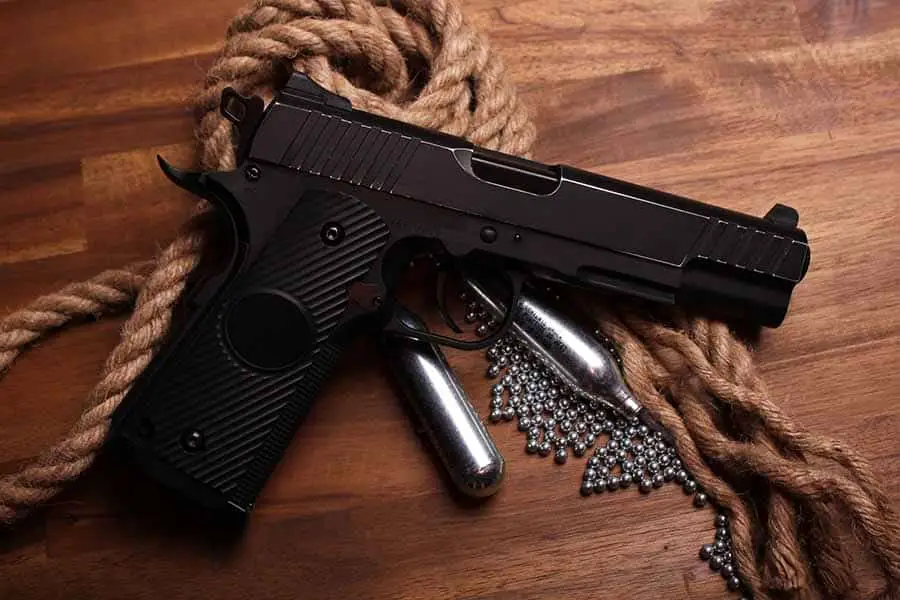If you’ve ever played paintball and been shot somewhere that wasn’t fully protected, you probably have a good idea about what being stabbed would feel like. Paintball pain was some of the worst pain I’ve felt – where I was supposed to be having fun (probably because I was shot in the neck)!
So I had to know, does airsoft hurt as much as a paintball pellet? I know airsoft BBs are much smaller, and plastic, but they travel fast and don’t break upon impact. Paintball guns (the more correct term is “paintball marker”) aren’t very accurate but they certainly shoot fast so it kinda hurts to get hit.
If you’ve played paintball, then you might feel comfortable gauging airsoft pain off of that benchmark (like saying “paintball is a nine on the pain scale – so airsoft is a four” – that makes it more measurable). We recently wrote about the difference in pain between paintball and airsoft.
But what if you’ve never played paintball? You don’t have any frame of reference if someone says “it’s about half as painful as paintball”.
We set out to describe airsoft pain in the following article.
If you’ve been interested in airsoft for a while but have yet to actually play, one of the first questions you’re likely to have is how much it hurts to get shot with one of those little plastic pellets.
The answer to whether or not airsoft hurts is: not very much. Or a lot. Or maybe somewhere in between. It varies based on where you get shot and what you’re wearing. A lot of airsoft participants describe the pain from airsoft to being similar to a wasp sting or an ant bite (but without the lingering pain) if on bare skin.

The truth is, a number of conditions can influence the “ouch factor” of a rousing airsoft game. Fortunately, there are also some simple steps you can take to keep yourself protected and make sure you have as much good, clean fun as possible.
What Does It Feel Like to Get Shot With an Airsoft Gun?
We won’t sugarcoat it—it hurts. Exactly how bad depends on a few factors. The first is your individual pain threshold.
“Pain threshold” is just a fancy-sounding way of describing how well you tolerate pain. Needless to say, such perception-based judgments are very subjective. Everybody’s got a pain threshold, and they’re all a little different. That’s why it’s tough to give a straightforward, definitive answer to a question like, “Does airsoft hurt?”
A sensation that rates a 3 on another person’s pain scale might be a 7 on yours. Or it might be the other way around. Most battle-tested players liken being shot with an airsoft gun at close-to-moderate range to a bee sting, a hard pinch, or a mean-spirited whack with a stick.
There’s a chance that you could find it markedly more unpleasant, but it’s equally likely that you’ll barely even register it in the madness of the moment, especially if your adrenaline is pumping. There’s no other way to find out than to give it a shot (no pun intended).
That being said, if you tend to do everything in your power to avoid pain, airsoft might not be a hobby for you. It’s an intense and highly physical activity by nature, and it’s simply not possible to get in on the action without having to deal with some degree of discomfort.
What Is the Standard Speed of Airsoft Weapons?
A typical spring-action airsoft gun fires pellets at a speed of 200-400 ft/s, or feet per second (and upwards of 600 ft/s for sniper rifles and other long-range weapons). In scientific terms, that’s pretty damn quick.
Obviously, the faster the pellet is moving at the moment it strikes you, the more it’s going to be smart. But it’s more than a matter of sheer velocity—you also can’t ignore the relationship between distance and damage.
A discharged pellet has the greatest amount of kinetic energy behind it when it first leaves the barrel. The farther away it travels, however, the more it slows down. As such, most hits will hurt considerably less at 80 or 90 feet than they would at, say, 30.
No matter what range you get tagged, it won’t feel like a warm hug. At the same time, it shouldn’t leave you writhing on the ground in unbearable agony or distract you from what’s going on around you for more than a second or two.
An airsoft game is designed to simulate a military operation (that’s why many airsoft players refer to it as “MILSIM” which is short for military simulation). And just like if you were in war with a real firearm, if you get shot, you should know it. This is why airsoft fields are usually designed to look like real scenes and scenarios from actual military combat.
The point of this is that airsoft should simulate an actual scenario whereby if you get shot you should know it. It should temporarily distract you and alert you to the fact that you’ve been shot – albeit and fortunately, it’s not as severe pain as being shot in real life!
So the airsoft projectile should have enough speed and kinetic energy to make an airsoft player know they’ve been hit. That speed seems to be between 300 and 600 fps – depending on the weapon (a sniper rifle usually shoots much faster because of the typical distance required to be effective).

How Much Does Airsoft Hurt on Bare Skin?
Yes, it will hurt unprotected skin. Without a buffer between your tender extremities and a dense plastic pellet rocketing along at a rate of 300 ft/s, you’re in for a pretty miserable experience. And the pain will only multiply the more times you get drilled.
It’s not uncommon for underdressed players to go home with some pretty nasty welts. Airsoft pellets can even break the skin if they make contact just right (or just wrong). This can result in some pretty gruesome injuries, although most of them look worse than they are.
The moral of the story is that you should never, under any circumstances, play airsoft without taking proper safety precautions and wearing adequate safety equipment.
How to Protect Yourself & Make Airsoft Hurt Less
When it comes to mitigating the pain potential of a barrage of angry pellets, protective gear is your best friend.
Airsoft-specific protection comes in a wide variety of forms and fashions, from simple masks and face shields (which are a bare-minimum requirement to play at most venues and events) to full tactical body armor with all the trimmings.
You don’t necessarily need to hop into the fray suited up like a member of the riot squad, but it is a good idea to invest in a few basic pieces of equipment if you think you might be playing on a regular basis. You’ll be glad you did.
The most basic needs should protect your face, eyes and ears. You want to prevent eye injury first and foremost as this is the most commonly reported injury in airsoft matches. Goggles or full-face masks are recommended.
Shooting an airsoft rifle or pistol isn’t loud but the BBs are very small and can fit in smaller spaces. So we also recommend some sort of ear protection – if your full-face mask doesn’t already cover your ears.
What Areas Should You Cover?
At the very least, you’ll want to wear several layers of thick, durable, long-sleeved clothing and slip on a hard-shell face mask and/or shatterproof goggles. Eye protection is an absolute must in 100% of the games you play. Corneal abrasions, hyphema, and similar types of ocular abuse are by far the most common injuries associated with airsoft engagements.
A cushioned neck gaiter and fortified gloves will also be a plus, as the face, neck, and hands are all extremely sensitive and are considered by many to be among the most painful places on the body to get shot.
An additional kit is purely optional, but when in doubt, it never hurts to armor up.
Items such as helmets, chest protectors, gauntlets, shin and thigh guards, and knee and elbow pads can all bolster your defenses and let you focus on waging simulated war rather than finding a safe hiding spot where you can lay low for the remainder of the round.
Keep in mind, though, that weighing yourself down with excess equipment will compromise your speed and mobility, so it’s best to strive for a happy medium.
Can You Get Hurt Even With Protective Gear On?
Like we’ve said, that element of irreducible danger is one of the things that makes airsoft so exciting in the first place. Even if you are wearing protection, it could still hurt.
Even so, you’re more likely to get bruised up in a player-on-player collision or sprain your ankle sprinting for cover than you are to wind up with serious injuries as a result of being pelted with plastic BBs.
Try not to squander too much mental energy sweating the worst-case scenarios. Instead, use it to formulate a plan of attack for your next game of Team Deathmatch, Capture the Flag, or Last Man Standing.
The pain isn’t too bad so you shouldn’t worry much – after all, they do call it air-soft…






